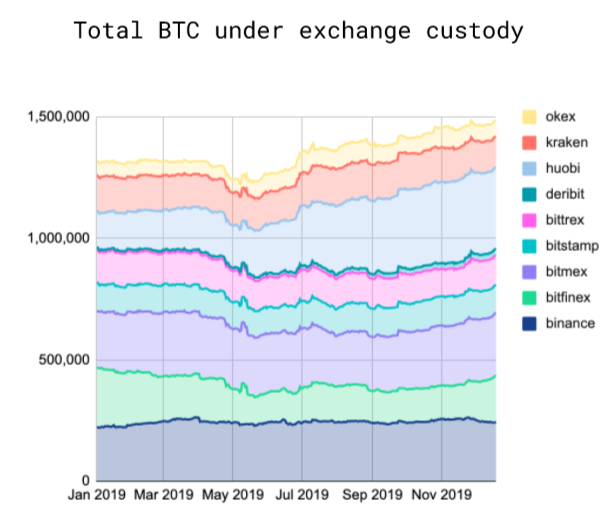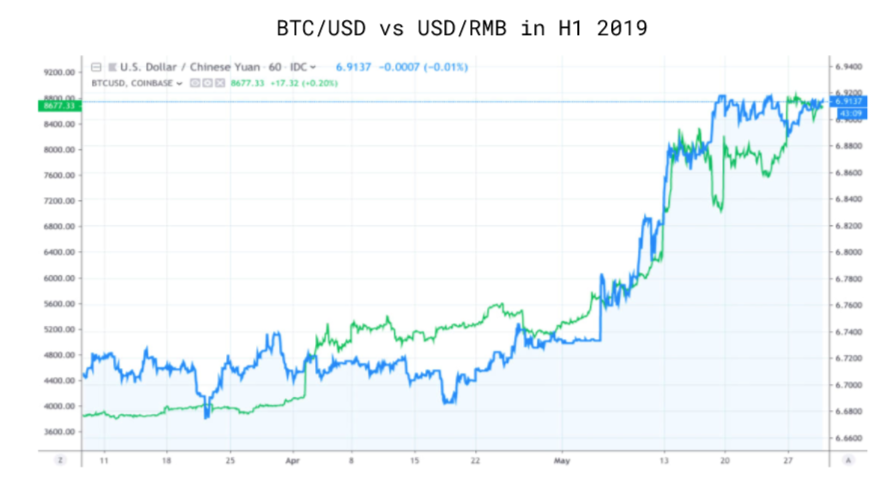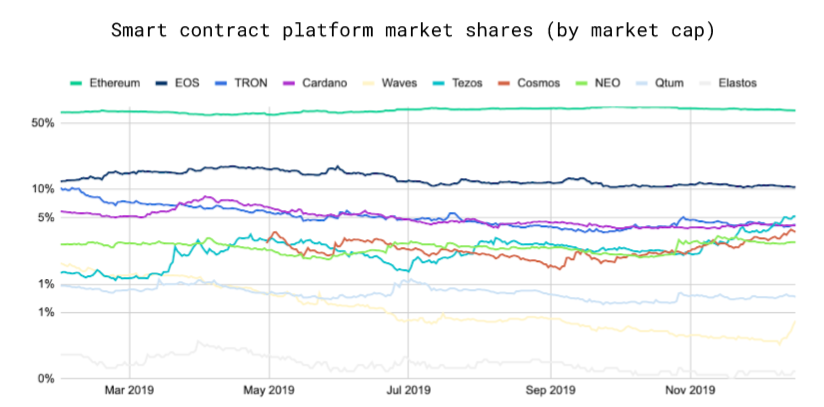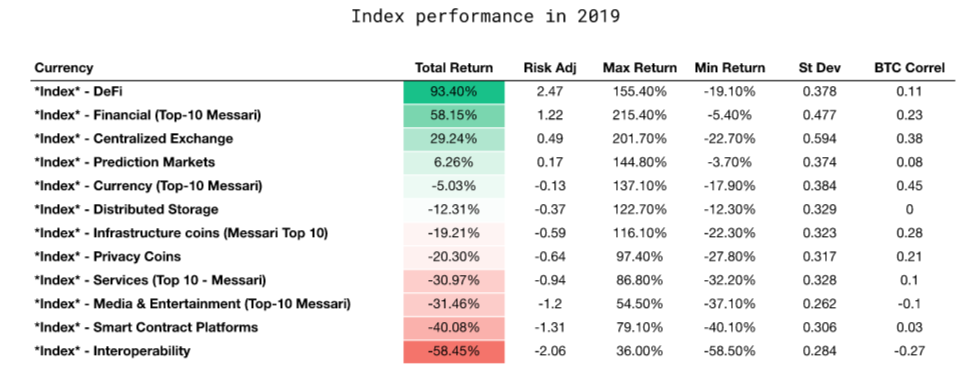Bitcoin and Ethereum, Permissionless Money and Finance Dominate Crypto
Money and DeFi show tremendous promise for cryptocurrency

Share this article
Two trends are pushing crypto forward—Bitcoin and its promise of permissionless money, and Ethereum and its promise of permissionless finance said the State of Crypto report. Both the store-of-value and DeFi narratives have the potential to create trillions in value.
Market Activity Picking Up Steam
Cryptocurrencies rebounded during the first half of 2019 after a lackluster 2018. Money was lost, but investor sentiment was by no means crippled.
Liquidity saw a healthy uptick as the broader market picked up from biennial lows. The bull rally in 2019 brought liquidity to centralized exchanges like Binance and Bitfinex. Nearly 1.5 million BTC, or 8.2% of circulating supply, was held in the custody of centralized exchanges on behalf of customers.

Going forward, exchanges may have to provide value-add services to establish sustainable profits. Proof-of-work (PoW) coins outperformed their proof-of-stake (PoS) counterparts that ended the year on a weak note. However, most of these PoS coins have seen strong market activity in 2020, with EOS, TRON, and Cardano up 34%, 19%, and 38% respectively against BTC.
Derivatives have seen significant traction in 2019 thanks to the launch of Bakkt, bringing a new influx of speculators. Binance, at one point, had a daily volume of $3 billion dollars on its futures products. BitMEX recently zoomed past $1 billion in open interest on its XBT/USD perpetual swap.
Options contracts may prove to be a central theme for derivatives going forward. Investor attention is shifting towards options as they provide a more efficient way of speculating and hedging existing positions.
Bitcoin Leads by Example
A takeaway from 2019 was Bitcoin’s continued dominance in the crypto market. Not only was Bitcoin the single best-performing cryptocurrency for the year, but the perception that Bitcoin is a store-of-value more than quadrupled, based on social media mentions.

In other news, BTC’s price action over the year was closely correlated to the devaluation of the Chinese yuan. During this time, Chinese investors started to move their assets out of the country’s financial system using Bitcoin and stablecoins, according to the correlation.

Questions emerged as to whether Bitcoin is a “risk-on” or “risk-off” asset. From a longer-term perspective, Bitcoin has existed during one of the longest bull runs of the century. Nobody can ascertain how Bitcoin will perform during a recession, which leaves the risk-on/risk-off question unanswered.
But one thing is certain: Bitcoin is being used as a financial instrument in times of uncertainty.
The inflow of capital as tensions escalated between the United States and Iran, as well as the current price action of BTC while global markets capitulate on Coronavirus fears stands as evidence to that.
Global uncertainty regarding the health of economies and monetary policy opens the door to more price appreciation for BTC. Coupled with the halving in less than six months, the perfect storm could be brewing for the genesis cryptocurrency.
PoW on Bitcoin is working like a well-oiled machine. Competition in the industry has been ramping up along with technological innovation for mining hardware. Geographical concentration of miners in Sichuan is a cause for concern. However, this risk is likely to be mitigated as more mining farms establish themselves in North America.
From a development perspective, developers and the community have their sights set on improving base-layer privacy. Schnorr signatures are considered the best way to fulfill this goal. Considering current progress, it is unlikely that Schnorr will be implemented during 2020, but the initial stages of implementation and testing should see significant progress.
Lightning hasn’t lived up to expectations, but development and integration haven’t slowed, either. Square, a $34 billion company, believes Lightning and Bitcoin are key to the future of money. The company has a lot of Lightning-based plans in the pipeline, as do various independent developers and Bitcoin native companies.
Growth in Ethereum and DeFi
The last couple of years were formative for cryptocurrency infrastructure development. Ethereum, in particular, has seen strong growth in developer infrastructure and tooling.
Smart contracts have been at the center of institutional adoption, with the likes of EY and Santander utilizing Ethereum-based solutions for their own use cases. Meanwhile, competitors to Ethereum, deemed “Ethereum killers,” don’t seem to be causing too much trouble for the original smart contract blockchain.

Block congestion on EOS caused the daily active users metric to steeply decline. TRON has established itself as a gambling chain, with the top four dApps on the protocol all raking in billions of TRX worth of activity.
But, one particular niche that Ethereum remains unrivaled on is that of DeFi, which attracted 225,000 unique users in 2019. For venture and retail investors alike, DeFi outperformed the broader cryptocurrency market, as per indexes by DecentralPark.

DEXes have been on a roll with $1.5 billion of volume on the top DEXes from mid-August 2019 to January of this year, as per data from Dune Analytics. Other aspects of DeFi, such as lending and derivatives, have done well and demonstrated a legitimate use case for decentralizing financial services.
However, despite the hype and excitement, one must understand DeFi is still in its infancy. Growth thus far has come from a concentrated group of existing techies. Access to crypto is still a major barrier to entry, even for those just looking to dabble. Risk in DeFi is another underestimated aspect of the stack. Smart contracts are code, and code is susceptible to bugs and vulnerabilities.
The high interest rates in DeFi might look appealing when compared to that of the traditional investments, but the risk of implosion may make the real reward to risk ratio even worse than that of sovereign Treasury bills.
Without intensive auditing and proper precautions, DeFi users could endure catastrophic losses.
“For DeFi to scale, a triumvirate needs to fall in place: regulation, user education, and business models. Business models can’t innovate and iterate unless there is a large user base, and that requires education. These models can’t evolve without regulation,” said Joel John, an analyst at Outlier Ventures and contributor to the State of Adoption report.
In the conversation with Crypto Briefing, he added:
“There will be an S-curve for DeFi’s adoption, but before it occurs, startups in DeFi will need to accrue runways long enough for the triumvirate to play out.”
Intuitive interfaces and the appeal of permissionless activity haven’t been enough to recruit a critical mass of people to DeFi thus far, so 2020 is expected to be the year where these applications prove themselves.
Overall, it seems the cryptocurrency markets are still dominated by two promising narratives—that of permissionless money through Bitcoin, and that of permissionless finance through Ethereum.
Share this article
